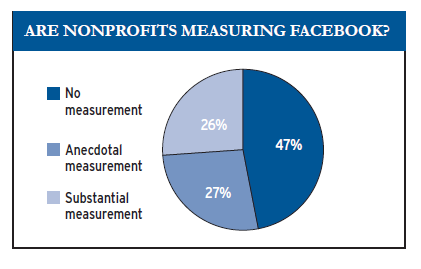
Malaise is a feeling of general discomfort or uneasiness, of being “out of sorts.” Lately, I’ve been hearing about “measurement malaise” infecting nonprofits and not just social media measurement. Maybe it is the feeling that measurement requires data collection and that will cause even more information overload and why we put the task on the organizational back burner.
Can you be an effective grassroots nonprofit organization in 21st century without a robust integrated social media and mobile strategy and measurement strategy? Idealware looked into this question about nonprofits and Facebook as well as other questions in its recent research study, Using Facebook to Meet Your Mission: Results of a Survey, available for free download with registration and discussed at free webinar on June 16 at 1 PM PST.. The survey looked at nonprofit’s self-reported results, goals, time investment, and measurement approaches for Facebook, although I wonder if you can really answer the big picture question without looking at how nonprofits use Facebook in the context of an integrated strategy and good measurement practice benchmarking study.

The Idealware survey asked participants if they measure results from Facebook. Their categories were based on whether or not the respondent was using a specific measurement tool like Facebook Insights or Google Analytics. Respondents that names tools were labled as “substantial.’ However it is hard to know whether or not if someone simply mentions the name of a tool whether or not they are using it appropriately to measure their results. The telling statistic is here is that 47% are not doing any measurement! More than half (53 percent) of survey respondents indicated measurement of some kind, while just 26 percent reported a “substantial” measurement plan. Of those respondents who reported a substantial measurement plan, almost 40 percent also reported some kind of tangible positive outcome of using Facebook, compared to less than 25 percent of those who were not measuring at all.
The survey also reports that over 60 percent of respondents who reported “substantial measurement” were still not seeing a positive impact from Facebook. This has more to do with their specific strategy and measurement practice rather than their use of the measurement tools. As measurement guru KD Paine says, you need the right measurement tool for the job – identify SMART objectives, pick metrics, and then your tool.
It made me curious about what keeps nonprofits from measuring integrated social media campaigns and why measurement often gets pushed to the backburner. Here’s a summary a responses from my Facebook Page.
1. Doing or Creating is More Fun Than Measurement: People are more likely to build instead of measure even if they are building on a fault line. Creating is more appealing then analysis to most. How can create a culture of fun around measurement so that we can’t keep ourselves from doing it from the beginning of a project.
2. Measurement Analytics Paralysis: There so much out there – from infographics to factoids to market research studies to endless tools we could use to measure our social media that we’ve become junkies of consuming analytics data for the sake of consuming analytics and playing with analytics tools. The line between where the data analysis stops and the real work begins gets blurry. Do we stop and ask if it is useful? Do we try to get data in small, digestible bytes and reflect on what it means? Maybe it is more fun to get lost in the lastest chart and graph we can generate in our social media analytics tool, but how can we harness our addiction to data to create more insight? One solution is to set aside a small block of time to think about the data, maybe a “Metrics Monday” as my colleagues at Momsrising do. We all need to be curators of our analytics data.
3. Fear: What We Might Learn: What if we discover that our campaign didn’t get the results we thought it would or even worse, that our precious time was wasted. Many nonprofit social media mavens are proud of their work, may be challanged to find things that truly capture the impact. Are we afraid that measurement will provide data for someone in our organization to say “social media is waste of time.” Or maybe we just don’t want to learn from failure and are not prepared to give something a joyful funeral or tweak it for success. Learning from failure is like compost – while it might stink at first, it gets valuable over time. It is also important to also learn from our successes in the event they happened by accident.
4. Rational Expections for Outcomes: It is more than setting SMART objectives which takes some focus. You have to put a flag in the sand and articulate what your outcome will be, whether grand or modest. You also have step away from your overloaded to do list and clarify. I’m also reminded of a quote from Michelangelo, “The greatest danger for most of us is not that our aim is too high and we miss it but that it is too low and we reach it.” SMART objectives and a measurement plan are not a report card! They are guide posts for improvement.
5. Picking the Right Metrics: Understanding the right metrics to use to measure your results, without defaulting to “measure everything” because more data is better or getting distracted by bogus and meaningless metrics. Here’s where I think the AMEC Valid Metrics Grids will be very useful. And, we have to be comfortable to just saying now and understand that we can measure to our capacity! Why not think about scaffolding what you measure? Strategically add metrics to your dashboard — sort of like trainng for marathon. Less is more.
6. Balance of Reflection and Action: Taking the time to clarify what you’re measuring might kill the excitement of experimentation and doing it – and that initial learning. But you can only dabble for so long – and to get to real results, you need a game plan for measuring. The problem is using measurement planning as an excuse not to experiment and learn with social media or mobile or as Jessica Dailey says, “If you are spending more time quantifying your relationships then you’re spending nurturing your relationships you’re doing it wrong in both life and social media.” There is the fun wild experimentation phase, but as practice matures you need a measurement strategy.
7. Measurement Is Expensive and Exhausting: The notion that the only valid measurement is done by highly trained specialists or that for the data to be valid it takes a lot of data collection and time – that many nonprofits simply don’t have. IF done in-house, staff view it as more work and the results of measuring is only as good as the input and if there’s no input, or sparse input it won’t tell us anything.
Does your organization have measurement malaise? What does it look like? More importantly, what’s the cure?
Beth Kanter is a consultant, author, influencer. virtual trainer & nonprofit innovator in digital transformation & workplace wellbeing.

Leave a Reply